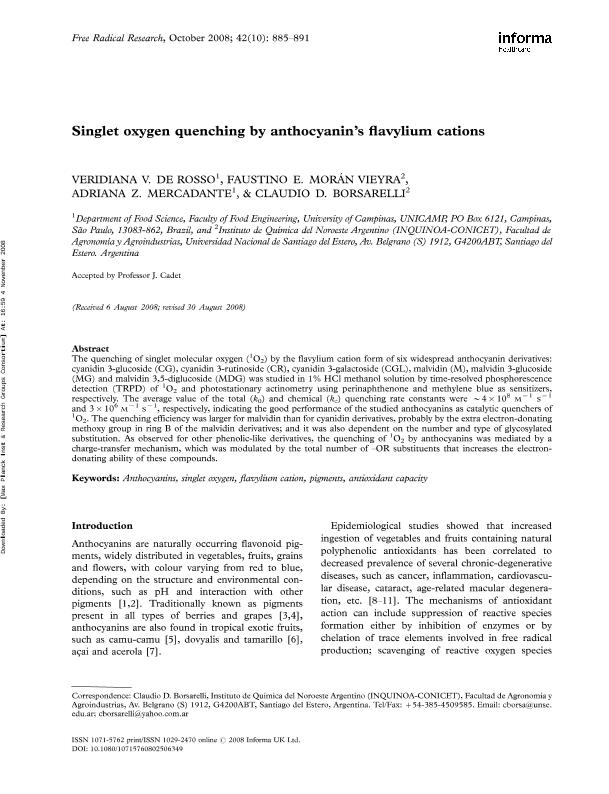Mostrar el registro sencillo del ítem
dc.contributor.author
Rosso, Veridiana V. De
dc.contributor.author
Moran Vieyra, Faustino Eduardo

dc.contributor.author
Mercadante, Adriana Z.
dc.contributor.author
Borsarelli, Claudio Darío

dc.date.available
2018-08-07T22:30:01Z
dc.date.issued
2008-12
dc.identifier.citation
Rosso, Veridiana V. De; Moran Vieyra, Faustino Eduardo; Mercadante, Adriana Z.; Borsarelli, Claudio Darío; Singlet oxygen quenching by anthocyanin's flavylium cations; Taylor & Francis; Free Radical Research; 42; 10; 12-2008; 885-891
dc.identifier.issn
1071-5762
dc.identifier.uri
http://hdl.handle.net/11336/54522
dc.description.abstract
The quenching of singlet molecular oxygen (1O2) by the flavylium cation form of six widespread anthocyanin derivatives: cyanidin 3-glucoside (CG), cyanidin 3-rutinoside (CR), cyanidin 3-galactoside (CGL), malvidin (M), malvidin 3-glucoside (MG) and malvidin 3,5-diglucoside (MDG) was studied in 1% HCl methanol solution by time-resolved phosphorescence detection (TRPD) of 1O2 and photostationary actinometry using perinaphthenone and methylene blue as sensitizers, respectively. The average value of the total (k0) and chemical (kc) quenching rate constants were ∼ 4×108 M-1 S-1 and 3×106 M-1 S-1, respectively, indicating the good performance of the studied anthocyanins as catalytic quenchers of 1O2. The quenching efficiency was larger for malvidin than for cyanidin derivatives, probably by the extra electron-donating methoxy group in ring B of the malvidin derivatives; and it was also dependent on the number and type of glycosylated substitution. As observed for other phenolic-like derivatives, the quenching of 1O2 by anthocyanins was mediated by a charge-transfer mechanism, which was modulated by the total number of -OR substituents that increases the electron-donating ability of these compounds.
dc.format
application/pdf
dc.language.iso
eng
dc.publisher
Taylor & Francis

dc.rights
info:eu-repo/semantics/openAccess
dc.rights.uri
https://creativecommons.org/licenses/by-nc-sa/2.5/ar/
dc.subject
Anthocyanins
dc.subject
Antioxidant Capacity
dc.subject
Flavylium Cation
dc.subject
Pigments
dc.subject
Singlet Oxygen
dc.subject.classification
Otras Ciencias Químicas

dc.subject.classification
Ciencias Químicas

dc.subject.classification
CIENCIAS NATURALES Y EXACTAS

dc.title
Singlet oxygen quenching by anthocyanin's flavylium cations
dc.type
info:eu-repo/semantics/article
dc.type
info:ar-repo/semantics/artículo
dc.type
info:eu-repo/semantics/publishedVersion
dc.date.updated
2018-08-06T14:25:31Z
dc.identifier.eissn
1029-2470
dc.journal.volume
42
dc.journal.number
10
dc.journal.pagination
885-891
dc.journal.pais
Reino Unido

dc.journal.ciudad
Londres
dc.description.fil
Fil: Rosso, Veridiana V. De. Universidade Estadual de Campinas; Brasil
dc.description.fil
Fil: Moran Vieyra, Faustino Eduardo. Consejo Nacional de Investigaciones Científicas y Técnicas. Centro Científico Tecnológico Conicet - Tucumán. Instituto de Química del Noroeste. Universidad Nacional de Tucumán. Facultad de Bioquímica, Química y Farmacia. Instituto de Química del Noroeste; Argentina
dc.description.fil
Fil: Mercadante, Adriana Z.. Universidade Estadual de Campinas; Brasil
dc.description.fil
Fil: Borsarelli, Claudio Darío. Consejo Nacional de Investigaciones Científicas y Técnicas. Centro Científico Tecnológico Conicet - Tucumán. Instituto de Química del Noroeste. Universidad Nacional de Tucumán. Facultad de Bioquímica, Química y Farmacia. Instituto de Química del Noroeste; Argentina
dc.journal.title
Free Radical Research

dc.relation.alternativeid
info:eu-repo/semantics/altIdentifier/doi/http://dx.doi.org/10.1080/10715760802506349
dc.relation.alternativeid
info:eu-repo/semantics/altIdentifier/url/https://www.tandfonline.com/doi/abs/10.1080/10715760802506349
Archivos asociados
